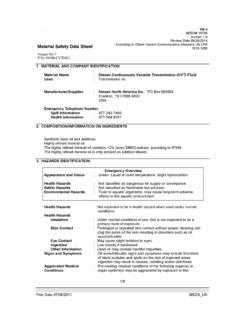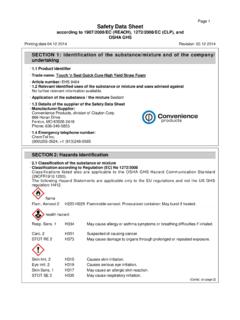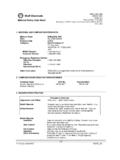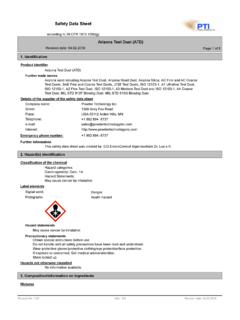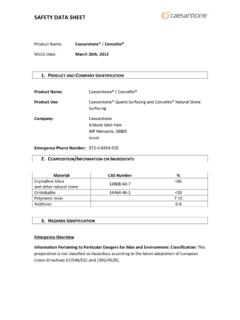Transcription of Safety Data Sheet - PSV Glass
1 Product Name: BETABRADE(TM) F1 Revision Date: 2011/04/28 Print Date: 24 Apr 2012 (TM)*Trademark Page 1 of 9 Dow Chemical Company Ltd encourages and expects you to read and understand the entire (M)SDS, as there is important information throughout the document. We expect you to follow the precautions identified in this document unless your use conditions would necessitate other appropriate methods or actions. Section 1. Identification of the substance/preparation and of the company/undertaking Product identifiers Product Name BETABRADE F1 Relevant identified uses of the substance or mixture and uses advised against Identified uses A Glass cleaner -- For use in automotive applications. Details of the supplier of the Safety data Sheet COMPANY IDENTIFICATION Dow Chemical Company Ltd Diamond House, Lotus Park Kingsbury Crescent TW18 3AG Staines, Middlesex United Kingdom Customer Information Number: 0203 139 4000 EMERGENCY TELEPHONE NUMBER 24-Hour Emergency Contact: 0031 115 694 982 Local Emergency Contact: 00 31 115 69 4982 Section 2.
2 Hazards Identification Classification of the substance or mixture Classification according to EU Directives 67/548/EEC or 1999/45/EC This product is not classified as dangerous according to EC criteria. Label elements Labelling according to EC Directives This product is not classified as dangerous according to EC criteria. Safety data Sheet Dow Chemical Company Ltd Product Name: BETABRADE(TM) F1 Revision Date: 2011/04/28 Page 2 of 9 Safety data Sheet available for professional users on request. Other Hazards No information available. Mixture This product is a mixture. CAS-No. / EC-No. / Index REACH No. Amount Component Classification: REGULATION (EC) No 1272/2008 CAS-No. 1344-28-1 EC-No. 215-691-6 > - < % Aluminium oxide## Not classified CAS-No. 7732-18-5 EC-No. 231-791-2 > - < % Water## Not classified CAS-No. 8042-47-5 EC-No. 232-455-8 > - < % White mineral oil (petroleum) Not classified CAS-No. / EC-No. / Index Amount Component Classification: 67/548/EEC CAS-No.
3 1344-28-1 EC-No. 215-691-6 > - < % Aluminium oxide## Not classified. CAS-No. 7732-18-5 EC-No. 231-791-2 > - < % Water## Not classified. CAS-No. 8042-47-5 EC-No. 232-455-8 > - < % White mineral oil (petroleum) Xn: R65 ## Voluntarily disclosed component(s). For the full text of the H-Statements mentioned in this Section, see Section 16. See Section 16 for full text of R-phrases. Section 4. First-aid measures Description of first aid measures Section 3. Composition/information on ingredients Product Name: BETABRADE(TM) F1 Revision Date: 2011/04/28 Page 3 of 9 General advice: First Aid responders should pay attention to self-protection and use the recommended protective clothing (chemical resistant gloves, splash protection). If potential for exposure exists refer to Section 8 for specific personal protective equipment. Inhalation: Move person to fresh air. If not breathing, give artificial respiration; if by mouth to mouth use rescuer protection (pocket mask, etc).
4 If breathing is difficult, oxygen should be administered by qualified personnel. Call a physician or transport to a medical facility. Skin Contact: Remove material from skin immediately by washing with soap and plenty of water. Remove contaminated clothing and shoes while washing. Seek medical attention if irritation persists. Wash clothing before reuse. Discard items which cannot be decontaminated, including leather articles such as shoes, belts and watchbands. Eye Contact: Flush eyes thoroughly with water for several minutes. Remove contact lenses after the initial 1-2 minutes and continue flushing for several additional minutes. If effects occur, consult a physician, preferably an ophthalmologist. Suitable emergency eye wash facility should be available in work area. Ingestion: If swallowed, seek medical attention. Do not induce vomiting unless directed to do so by medical personnel. Most important symptoms and effects, both acute and delayed Aside from the information found under Description of first aid measures (above) and Indication of immediate medical attention and special treatment needed (below), no additional symptoms and effects are anticipated.
5 Indication of immediate medical attention and special treatment needed Maintain adequate ventilation and oxygenation of the patient. If excessive inhalation of mineral oil mist is suspected, observe for lung injury (lipoid pneumonia). No specific antidote. Treatment of exposure should be directed at the control of symptoms and the clinical condition of the patient. Section 5. Fire Fighting Measures Extinguishing Media This material does not burn. If exposed to fire from another source, use suitable extinguishing agent for that fire. Special hazards arising from the substance or mixture Hazardous Combustion Products: Not applicable Unusual Fire and Explosion Hazards: None known. Advice for firefighters Fire Fighting Procedures: Keep people away. Isolate fire and deny unnecessary entry. Do not use direct water stream. May spread fire. Special Protective Equipment for Firefighters: Wear positive-pressure self-contained breathing apparatus (SCBA) and protective fire fighting clothing (includes fire fighting helmet, coat, trousers, boots, and gloves).
6 If protective equipment is not available or not used, fight fire from a protected location or safe distance. Section 6. Accidental Release Measures Personal precautions, protective equipment and emergency procedures: Isolate area. Keep unnecessary and unprotected personnel from entering the area. No smoking in area. Refer to Section 7, Handling, for additional precautionary measures. Use appropriate Safety equipment. For additional information, refer to Section 8, Exposure Controls and Personal Protection. Environmental precautions: Prevent from entering into soil, ditches, sewers, waterways and/or groundwater. See Section 12, Ecological Information. Methods and materials for containment and cleaning up: Contain spilled material if possible. Collect in suitable and properly labeled containers. See Section 13, Disposal Considerations, for additional information. Product Name: BETABRADE(TM) F1 Revision Date: 2011/04/28 Page 4 of 9 Section 7. Handling and Storage Precautions for safe handling Handling General Handling: Keep away from heat, sparks and flame.
7 Avoid contact with eyes, skin, and clothing. Avoid prolonged or repeated contact with skin. Wash thoroughly after handling. Keep container closed. Use with adequate ventilation. Containers, even those that have been emptied, can contain vapors. Do not cut, drill, grind, weld, or perform similar operations on or near empty containers. See Section 8, EXPOSURE CONTROLS AND PERSONAL PROTECTION. Conditions for safe storage, including any incompatibilities Storage Keep container tightly closed and in a well-ventilated place. Shelf life: Use within Storage temperature: 18 Months > 5 - < 30 C Specific end uses See the technical data Sheet on this product for further information. Section 8. Exposure Controls / Personal Protection Control parameters Exposure Limits Component List Type Value |White mineral oil (petroleum) ACGIH TWA Inhalable fraction. 5 mg/m3 Although some of the fillers used in this product may have exposure guidelines, no exposure would be expected under normal handling conditions because of the physical state of the material.
8 Exposure controls Personal Protection Eye/Face Protection: Use Safety glasses (with side shields). Safety glasses (with side shields) should be consistent with EN 166 or equivalent. Skin Protection: Wear clean, body-covering clothing. Hand protection: Use gloves chemically resistant to this material when prolonged or frequently repeated contact could occur. Use chemical resistant gloves classified under Standard EN374: Protective gloves against chemicals and micro-organisms. Examples of preferred glove barrier materials include: Neoprene. Nitrile/butadiene rubber ( nitrile or NBR ). Polyvinyl chloride ( PVC or vinyl ). Avoid gloves made of: Polyvinyl alcohol ( PVA ). When prolonged or frequently repeated contact may occur, a glove with a protection class of 5 or higher (breakthrough time greater than 240 minutes according to EN 374) is recommended. When only brief contact is expected, a glove with a protection class of 3 or higher (breakthrough time greater than 60 minutes according to EN 374) is recommended.
9 NOTICE: The selection of a specific glove for a particular application and duration of use in a workplace should also take into account all relevant workplace factors such as, but not limited to: Other chemicals which may be handled, physical requirements (cut/puncture protection, dexterity, thermal protection), potential body reactions to glove materials, as well as the instructions/specifications provided by the glove supplier. Respiratory Protection: Respiratory protection should be worn when there is a potential to exceed the exposure limit requirements or guidelines. If there are no applicable exposure limit requirements or guidelines, wear respiratory protection when adverse effects, such as respiratory irritation or discomfort have been experienced, or where indicated by your risk assessment process. In misty atmospheres, use an approved particulate respirator. For emergency conditions, use an approved Product Name: BETABRADE(TM) F1 Revision Date: 2011/04/28 Page 5 of 9 positive-pressure self-contained breathing apparatus.
10 Use the following CE approved air-purifying respirator: Organic vapor cartridge with a particulate pre-filter, type AP2. Ingestion: Use good personal hygiene. Do not consume or store food in the work area. Wash hands before smoking or eating. Engineering Controls Ventilation: Use engineering controls to maintain airborne level below exposure limit requirements or guidelines. If there are no applicable exposure limit requirements or guidelines, use only with adequate ventilation. Local exhaust ventilation may be necessary for some operations. Section 9. Physical and Chemical Properties Information on basic physical and chemical properties Appearance Physical State Liquid. Color White Odor Orange Odor Threshold No test data available pH Not applicable Melting Point Not applicable Freezing Point No test data available Boiling Point (760 mmHg) Not applicable. Flash Point - Closed Cup 79 C Vendor Evaporation Rate (Butyl Acetate = 1) No test data available Flammability (solid, gas) Not applicable to liquids Flammable Limits In Air Lower: Not applicable Upper: Not applicable Vapor Pressure Not applicable Vapor Density (air = 1) No test data available Specific Gravity (H2O = 1) Vendor Solubility in water (by weight) Partially soluble Partition coefficient, n-octanol/water (log Pow) No test data available Autoignition Temperature No test data available Decomposition Temperature No test data available Dynamic Viscosity No test data available Kinematic Viscosity No test data available Explosive properties no data available Oxidizing properties no data available Other information Section 10.
